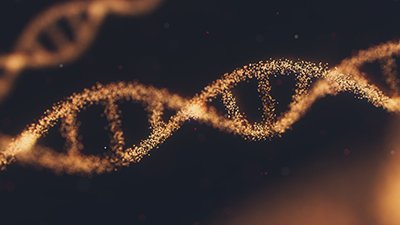
Nothing New Under the Sun: Media Report Hypes Evolution Claims
A recent article from The Washington Post had the headline, “New Analyses Bolster Central Tenets of Evolution Theory.”
A recent article from the Washington Post had the headline: “New Analyses Bolster Central Tenets of Evolution Theory.”1 In it, Rick Weiss and David Brown boast about evolution’s “power to predict the unexpected” and how well the theory of evolution stands up to “some tough new tests.” They also marvel at the audacity of the Dover, Pennsylvania, USA school board to question evolution by putting it “on par with ‘alternative’ explanations such as Intelligent Design.”2
Although there are some new evolutionary arguments discussed, the article offers the usual hype that "evolution has been proven" and the creationists should just give up and go home.3
Front and center in the article is the report on the recent sequencing of the chimpanzee genome and the 96% similarity to human DNA. Evolution supporters now insist that the 4% difference came as no surprise and “proves” that humans and apes share a common ancestor in spite of the fact that it is essentially double the difference of previous estimates.4 One would suspect that researchers such as Morris Goodman must have been disappointed. Goodman and his research team had noted much higher similarity between coding DNA from chimps and humans. Indeed, they saw the similarity as so great that the researchers even suggested that chimpanzees should rightfully be placed in the same genus as man.5
In addition, there are numerous significant differences between the chimp and human genomes.6
A New Evolution Argument Based on the Chimpanzee Genome
Nonetheless a new argument that makes use of the chimpanzee sequence has arisen. Researchers were able to “predict the number of harmful mutations in the chimpanzee DNA by knowing the number of mutations in a different species’ DNA and the two animals’ population size.” The work was done by Eric Lander and colleagues who confirmed that “a harmful mutation is unlikely to persist if it is serious enough to reduce an individual’s odds of leaving descendants by an amount that is greater than the number one divided by the population of that species.”
Exactly why this is such a great victory for evolution is far from clear.
Scientists had previously determined the values for mice and are working them out for dogs. As it turns out, dogs have a population number between apes (which are fewer) and mice (which are more numerous) and likewise have an intermediate number of harmful mutations. Exactly why this is such a great victory for evolution is far from clear.
First, such a hypothesis is also completely consistent with a creationist model. The number of harmful mutations (sometimes referred to as “genetic load”) that a population can carry should be proportional to the size of the population and be limited by how deleterious the mutation is. Predicting the number of harmful mutations only demonstrates common features of population genetics, which is a mathematical, operational science accepted by creationists and evolutionists alike. The fact that this can be done using different species does not provide evidence of common ancestry between the different species. It simply demonstrates the role of population size on the amount of genetic load that a population can bear. Since creationists recognize deterioration and mutations since the Fall, there is no uniquely evolutionist prediction here.
Second, predicting the maximum genetic load of a population does not really help with evolution’s greatest obstacle. The important issue is not the number of harmful mutations that can exist in a population but the number of necessary “beneficial” mutations that can become fixed in a population. One would expect that a similar rule applies to beneficial mutations. In other words, for such a beneficial mutation to become fixed in the population, it will have to increase an individual’s fitness. Further, just because an individual has a beneficial mutation for one gene does not mean that it will not have a harmful mutation in another gene.
The same population dynamics that make it difficult to eliminate slightly harmful mutations also make it difficult for beneficial mutations to become present in all members of the population.7 Since any mutation begins in one chromosome in one individual in the whole population, it is believed to take many thousands to millions of generations to become fixed unless it is a massive advantage like resistance to a toxin or diseases.8 In this or other cases, the population must go through a huge population bottleneck (serious decrease in the population size), which then means that it takes many generations to rebuild the population. This also would eliminate other putative evolving genes which have not become fixed (i.e., universal) in the population.
Thus, scientists believe that most mutations that become fixed in the population do so through random genetic drift. Indeed, this is the explanation offered for the majority of the fixed differences between chimpanzees and man in the report on the chimp genome sequence.9 A conclusion from evolution by random genetic drift is that genetic variation is eventually lost in a population as one or the other form of a gene is lost.10 Therefore, both random genetic drift and population bottlenecks severely limit the genetic variation which is the raw material of evolution by natural selection.
Rather than a glowing demonstration of the “power” of evolution, this argument highlights its intrinsic weakness. Moreover, there is no evidence for common ancestry provided from such analysis.
“Junk” DNA: The Argument That Refuses to Die
Weiss and Brown interviewed John West of the Discovery Institute (the leading intelligent design think tank) for their article and asked for examples of “non-obvious, testable predictions made by the theory of Intelligent Design.” West correctly noted an ID prediction that “junk” DNA would be shown to have functions since “an intelligent designer would not fill animals’ genomes with DNA that had no use.” However, the authors appeared unsatisfied with this answer perhaps because it demonstrates that ID could qualify as science. They rebut West with the statement that although “some ‘junk’ DNA has indeed been found to be functional in recent years … more than 90 percent of human DNA still appears to be the flotsam of biological history.” The authors imply that there is 90% of human DNA which is still “junk.” This is completely false.
While only about 1% of human DNA codes for the amino acid sequence of proteins,11 substantially more than 10% has been assigned functions. In addition to the genes, there are stretches of DNA that serve as regulatory regions which help determine when, where and how much of each protein is made. Much of the repeating sequences have functions, including the telomeres that protect the end of chromosomes as well as the satellite DNA at the centromere, which serves as the binding site for the protein complex that separates chromosomes during cell division.12 Other repetitive elements including Alu and L1 are believed to have functions serving as cohesion binding sites and DNA repair respectively. Still more, possibly 30% or more, DNA functions during development.13 Altogether this brings the percent of functional DNA significantly higher. The amount of functional DNA is expected to climb as more and more functions are uncovered.
Giraffes: The Myth That Refuses to Die
In discussing the role of natural selection in evolution, the Washington Post writers used the giraffe as a prime example.
Giraffes do not decide to grow long necks to browse the high branches above the competition. But a four-legged mammal on the savannah once upon a time was endowed with a longer neck than its brother and sisters. It ate better. We call its descendants giraffes.
The giraffe is often used as an example of contrast between Lamarck’s idea of acquired characteristics with Darwin’s natural selection. According to Lamarck, as the giraffe stretched its neck to reach leaves on taller trees, it passed this trait on to its offspring. Darwin’s Origin seemed to accept Lamarck’s idea of inheritance (which we now know to be wrong) to explain the fact that giraffes had a variety of neck lengths. (Today, in the neo-Darwinian view, the reason for variety is ultimately mutation-genetic copying mistakes). But he added the seemingly obvious factor of natural selection. The scenario is that during drought, short-necked giraffes would be selected against which would leave only those with long necks to survive and reproduce.
This classic example of the power of evolution, however, cannot possibly work in the way most people have believed. In a very interesting article about selection and the giraffe, 14 Craig Holdrege reviews some very serious challenges to the widely accepted story of the origin of the giraffe’s long neck. Some of the problems include:
If only leaves from the highest branches were available to giraffes for food, then multiple species of browsing and grazing animals including antelope would have been eliminated. This is not the case.
Giraffes with long necks are larger overall and would require more food than the ones that were smaller and had shorter necks.
Male giraffes are typically up to a meter taller than the female giraffes. Baby giraffes of both genders are obviously short until they grow up. If the selection pressure for long necks is so great, it would seem to favor the elimination of the females. More importantly, what do the baby giraffes eat until they grow up? This type of selective pressure would seem to eliminate the offspring.
Giraffes today do not exclusively eat from the high branches. In fact, giraffes often eat at or below shoulder height.
From the perspective of drinking water, giraffes would actually seem to have necks that are too short since it is very awkward for them to bend over to reach the ground. To do so requires that their legs are splayed quite far apart in order for them to bring their head to ground level. Being able to reach water during a drought seems to be more important than reaching high branches for food.
An additional point that was not included in Holdrege’s article is that there is no fossil record demonstrating that giraffes with short necks ever existed.
There is also a problem of new structures being required in addition to the neck lengthening. A very large blood pressure, about double that of a normal mammal, is required to pump blood to the brain when the giraffe is upright. But when the giraffe bends down to drink, this blood pressure would be expected to blow its brains out. However, the giraffe neck has a rete mirabile (Latin for “wonderful net”), a complex network of blood vessels, which helps to equalize the pressure. Giraffe legs also have a thick sheath of skin, like an astronaut’s G-suit, to prevent the high blood pressure from forcing blood to leak through capillaries.
Thus, this classic story of Darwinian evolution is largely myth. In spite of a number of scientific studies documenting the feeding behavior of giraffes and that it is inconsistent with the widely held explanation for the origin of the long neck, this notion persists. Media reports and textbooks which continue to promote it ensure its survival. In addition, there are many other aspects of giraffe biology that are better interpreted within a creationist framework. 15
Conclusion
The writer of Ecclesiastes wisely noted, “What has been will be again, what has been done will be done again; there is nothing new under the sun
” (Ecclesiastes 1:9 (NIV)). In spite of media hype and exaggeration; regardless of “new analyses” and claims of “tough new tests,” there is still no good evidence to prove “from goo to the zoo” evolution. Upon further inspection, many such claims tend to support a creation model instead.
Dr. DeWitt is the director of the Center for Creation Studies and an associate professor of biology at Liberty University in Lynchburg, Virginia, USA. His Ph.D. is in neurosciences from Case Western Reserve University and the focus of his research is the cell biology of Alzheimer’s disease. Dr. DeWitt is the featured speaker on the video/DVD“Junk” DNA is not Junk from Answers in Genesis.
Footnotes
- Washington Post, Monday, Sept. 26, 2005.
- Sheppard, P., Defending “design” in Dover (Pennsylvania, USA). The Dover School Board was not putting evolution on par with Intelligent Design. They only wanted a statement read informing students about an ID book that was available in the library. ID was not taught in the classroom at all. Students were only made aware of available resources on it.
- DeWitt, D.A., Hox Hype
- DeWitt, D.A., Greater Than 98% Chimp/Human DNA Similarity? Not Any More., TJ 17(1):8-10.
- Wildman, D.E., Uddin, M., Liu, G., Grossman, L.I. and Goodman, M., Implications of natural selection in shaping 99.4% nonsynonymous DNA identity between humans and chimpanzees: Enlarging genus Homo, Proc. Natl. Acad. Sci. USA 100(12):7181-7188, 2003.
- DeWitt, D.A., Chimp Genome Sequence Very Different from Man. A more detailed analysis of the chimp genome study is currently in press in the next issue of TJ.
- Spetner, L.M., Not By Chance, The Judaica Press, Brooklyn, NY, 1996, 1997. .
- Remine, W.J., Cost theory and the cost of substitution-a clarification, TJ 19(1):113-125, 2005.
- The Chimpanzee Sequencing and Analysis Consortium, "Initial sequence of the chimpanzee genome and comparison with the human genome," Nature 437:69-87, 2005.
- Futuyma, D.J., Evolutionary Biology, 3rd Ed., p. 299, 1998.
- Venter et al., The Sequence of the Human Genome, Science 291:1304-1351.
- There are numerous articles and reviews about “junk” DNA function in TJ and Q&A: "Vestigial" Organs.
- Batten, D., No joy for junkies; Sarfati, J., DNA: marvelous messages or mostly mess?
- Holdrege, C., The Giraffe’s Short Neck, In Context #10, pp. 14-19 (Fall 2003) by The Nature Institute.
- Hofland, L., Giraffes … animals that stand out in a crowd, Creation 18(4):10-13, 1996.
Recommended Resources

Answers in Genesis is an apologetics ministry, dedicated to helping Christians defend their faith and proclaim the good news of Jesus Christ.
- Customer Service 800.778.3390
- © 2024 Answers in Genesis






